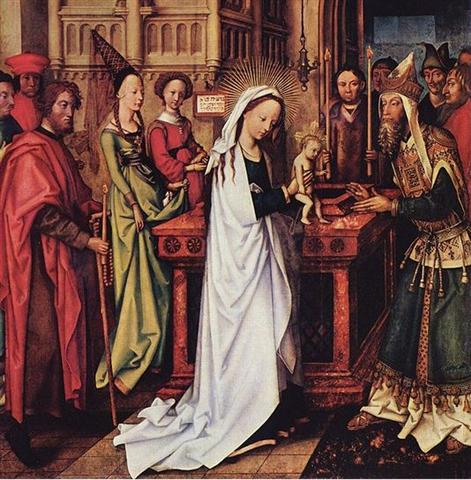5. Ga1-25 suddenly aquires a role of central importance for the calendar, because it evidently represents the day when a new (young) fire is kindled (a word which means both to set on fire and to bring forth young):
It is hard to avoid thinking about Candlemas (40 days beyond birth), when the new baby boy was brought into the temple, probably an idea not very much different from the Egyptian sanctuary of Upwaut, the Opener of the Way (i.e. the path of Sun):
"Under Mosaic law, a mother who had given birth to a man-child was considered unclean for seven days; moreover she was to remain for three and thirty days 'in the blood of her purification', which makes a total of 40 days." (Wikipedia) The Hawaiians counted to 33 days before winter solstice: ... the renewal of kingship at the climax of the Makahiki coincides with the rebirth of nature. For in the ideal ritual calendar, the kali'i battle follows the autumnal appearance of the Pleiades, by thirty-three days - thus precisely, in the late eighteenth century, 21 December, the winter solstice. The king returns to power with the sun ... The glyph type in Ga1-25 is tao:
Earlier I have summarized my interpretation of the tao glyph type as follows:
Tao apparently is a concept opposite to toa ('the old calabash') and it is hardly a coincidence that the words are alike, with alpha-omega reversed in toa. Dry branches are needed to make a fire. The 'red cloth' (tapa mea) presumably illustrates with feather signs in front the warmth flowing from the fire of life. A double-canoe needs 2 hulls, which could explain why there are 2 tao glyphs at the beginning of the text (presumably describing the arrival of the 'Son of Sun'):
Ga1-22 (at Mercury) could represent the canoe of the autumn waters and Ga1-25 the canoe of spring fire. In other words, correspond to Sun's Winter Maid respectively to his Summer Maid. We should remember the Egyptian canoes of 'night' respectively 'day':
If we count 40 days back in time we will find a curious Jupiter glyph (Gb8-16) in which is presented 2 fishes above what appears to be a Sun disc:
|
||||||||||||||||||||||||||||||||||||||||||||||||||||||||||||||||||||||||||||||||||||||||||||||||||||||||||||||||||||||||||
















